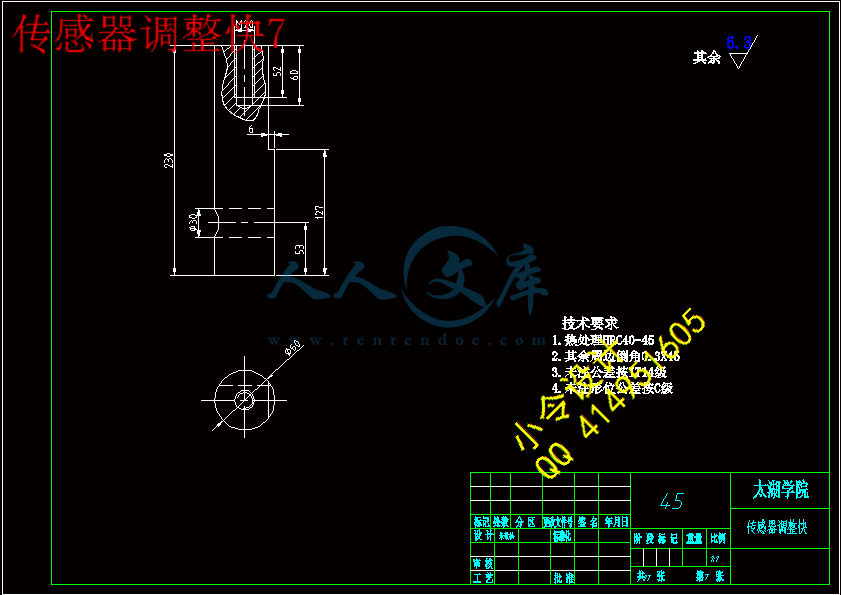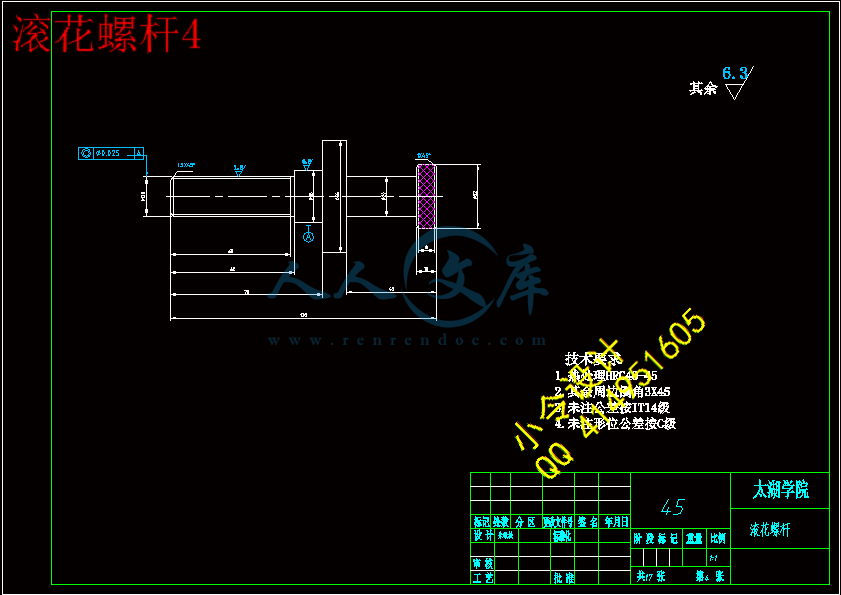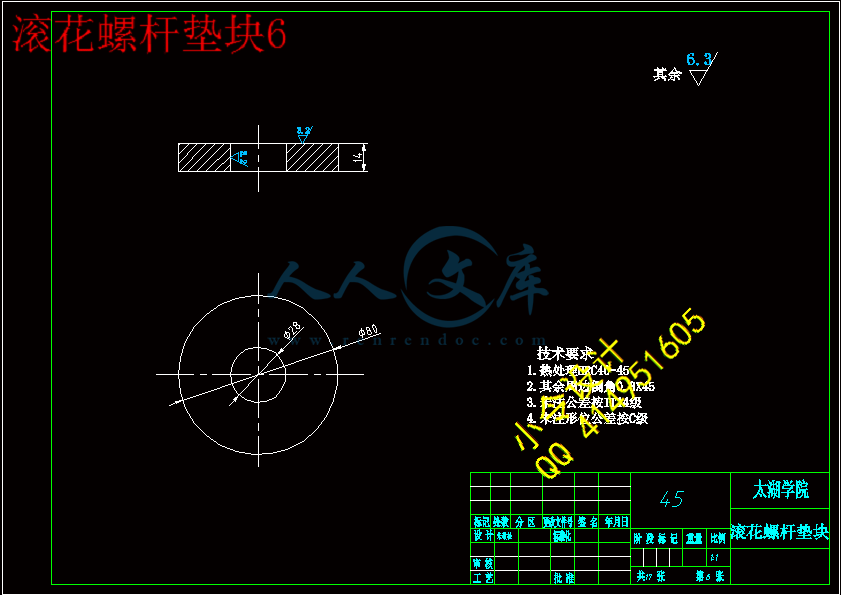【温馨提示】 购买原稿文件请充值后自助下载。
[全部文件] 那张截图中的文件为本资料所有内容,下载后即可获得。
预览截图请勿抄袭,原稿文件完整清晰,无水印,可编辑。
有疑问可以咨询QQ:414951605或1304139763
摘 要
本次毕业设计首先是对检测仪市场使用情况的数据进行采集工作,以确定设计的方案。
其次,分析所具备的条件因素,考虑厂方的成组技术要求,进行方案的制定。
最后,开始零件设计和重要零件三维绘图设计。
本仪器用于测量直齿或斜齿的圆柱齿轮的渐开线齿轮误差。这种仪器不需要不同尺寸的基圆盘。通过在仪器上的数控装置可以将被测工件的基圆半径调准到0.002MM.仪器表有电感比较仪,其传感器将被测工件齿形的渐开线误差传到指示电表上。本课题主要是着重与仪器机械结构方面的设计,并制作相关的三维软件,以满足设计改进,质量控制,售后服务,商务洽谈方面的要求。
目前在国内产品中销量很多。国产齿轮测量中心的质量和性能不断提高,已经具有和国外产品竞争的能力。不过在仪器精度、稳定性,尤其在测量软件、仪器故障诊断功能等方面,和国外还有一定差距。
关键词:渐开线;仪器精度;数控装置;传感器
Abstract
This graduation design is first acquisition work on the use of market detector data, to determine the design scheme.
Secondly, with analysis of factors, considering the requirements of group technology, make plan.
Finally, start part design and important parts of 3D graphics design.
This instrument is used for measuring the error of cylindrical gear involute spur or helical gear. This instrument does not need discs of different sizes. Through the numerical control device on the instrument can be measured workpiece radius of base circle aligned with the 0.002MM. instrument with inductance comparator, involute error of the sensor was measured the tooth profile of the workpiece to the indicating meter. This topic is mainly focuses on the design and equipment of mechanical structure, and fabrication of three-dimensional software related, in order to satisfy the design improvement, quality control, after sale service, business requirements.
At present in the domestic sales of many products. The quality and performance of domestic gear measuring center continuously improve, ability has competition and foreign products. But in the instrument accuracy, stability, especially in the aspect of software, measuring instrument fault diagnosis function, there is still a certain gap with foreign.
Key words: involute ;precision ;CNC device ; sensor
目录
摘 要III
AbstractIV
目录V
1绪论1
1.1 本课题的研究内容和意义1
1.2国内外的发展概况1
1.3本课题应达到的要求2
2 设计的要求及基本技术规格4
2.1 设计参数及要求4
2.2 设计任务及工作量4
2.3 设计内容4
2.3.2 设计说明书,翻译英文资料4
3 总体方案的设计原理5
3.1 总体方案的确定5
3.1.2 齿轮实际齿轮误差的测量5
3.2 原有仪器示意图6
3.3 总体方案的确定6
4 机械部分的设计与说明8
4.1 转动机构的设计8
4.2 导向机构的设计9
4.3 伺服驱动元件的设计10
5 机械传动部分的设计12
5.1 纵向导轨的选择12
5.1.1 承受载荷的估算:12
5.2 横向导轨的选择13
5.3滚珠丝杠副的计算13
5.3.2 额定动载荷的计算13
5.4稳定性验算14
5.5 轴承的选择17
5.5.1 寿命计算17
5.5.2 计算附加轴向力18
5.5.3 计算单个轴承的轴向载荷18
5.5.4计算当量动载荷18
5.5.5 寿命18
5.5.6 额定静载荷验算19
5.5.7 极限转速验算19
5.6 联轴器的选择19
5.7 键的选择与联接强度的计算22
5.8 步进电机的选择23
6 维护与保养25
7 结论和展望26
致谢27
参考文献29
1绪论
此次设计是我到单位设计的,在设计之前,我曾到公司参观了一台手动检测仪(如图1所示)对渐开线齿轮工作原理有了一些了解,并提出了这种数控改造方案。为了增加论文的可持续性和易懂性,在论文中配一些相关图解。
图 1.1 普通渐开线齿轮误差检测仪
1.1 本课题的研究内容和意义
本次毕业设计为了完全实现数控化,针对原有老式手动仪器的数控化改造,因此系统采新的机电一体化技术和元件器,现代的机械系统必然是由电脑控制的伺服系统,其中包含机电一体化机械系统,机电一体化集成电路的应用,微电子和接口技术,传感技术等。为了适应工业发展的需要,精密测量技术也需要得到长远发展。因此,再此次对渐开线齿轮检测仪进行数控化改造,使其在应用中获得更佳性能参数。
1.2国内外的发展概况
从上世纪80年代开始,齿轮测量中心的开发受到众多齿轮测量仪器制造商的重视;90年代逐步形成了系列化产品推向市场。CNC齿轮测量中心是信息技术、计算机技术和数控技术在齿轮测量仪器上集成应用的结晶,主要用于齿轮单项几何精度的检测,也可用于(静态)齿轮整体误差的测量。
德国KLINGELNBERG的P系列齿轮测量中心,其特点是采用了专利的三维数字式高精度光栅测量头(使用了HEINDENHAIN的超高精度光栅);性能稳定的优质铸铁床身,高性能直线电机驱动系统;高精度滚珠轴系和密珠滚动导轨。仪器精度达到德国标准1级。据报道该厂生产并经精化的一台P65齿轮测量中心,被英国国家齿轮计量实验室选定,作为英国齿轮精度传递及标定的基准仪器。美国M&M的齿轮测量中心,其三维高精度电感测量头;花岗石基座;精密气浮轴系以及精密直线滚动体结构导轨,成为该仪器的特色(近年也采用了直线电机驱动),仪器测量不确定度为2μm。德国MAHR的GMX275采用的模拟量测量头,可选择扫描或单点采样方式,可以按0.1°间距转动,使测头的测尖能处于被测齿面的法面上,仪器测量不确定度在测量空间内为(2.3μm+L/200)。国外齿轮测量中心厂商,大多还开发了测量软件和加工机床的参数修正软件,选用相关软件,还能用于反求工程对工件参数进行测定。高精度和一机多能的特点,使齿轮测量中心更适合于工厂计量站使用。日本的齿轮测量仪器制造商,在我国市场经过近十年的沉寂后近年来亮相频繁。大阪精机在GC-HP系列齿轮测量仪器的基础上,开发出CNC电子创成式的CLP系列齿轮测量仪器。特别值得一提的是最近在国内参展亮相的东京技术仪器公司(Tokyo Technical Instruments Inc.)。在2003年底上海中国国际齿轮传动、制造技术及装备展览会上该厂首次展出TTI-300E型CNC齿轮检测仪,据称其质量较小的测头部件能单独在径向运动,便于快速测量齿轮齿距偏差。密珠轴系的主轴回转精度可达0.03μm,仪器测量重复性达到0.5μm。
国内近年来,CNC齿轮测量中心有了长足的发展,哈尔滨量具刃具厂、哈尔滨精达公司都先后成功开发出了系列产品。哈量的3903A齿轮测量中心,经过几年努力,仪器精度和测量速度已达到或接近KLINGELNBERG公司产品的先进水平。精达公司作为后起之秀,发展引人瞩目,其JD、JDS系列齿轮测量中心。
目前在国内产品中销量很多。国产齿轮测量中心的质量和性能不断提高,已经具有和国外产品竞争的能力。不过在仪器精度、稳定性,尤其在测量软件、仪器故障诊断功能等方面,和国外还有一定差距。令人欣慰的是国内齿轮量仪制造商已有共识,已联合高校院所协同攻关努力缩小差距;随着性价比的迅速提高,参与市场竞争能力的增强,国产齿轮测量中心的发展前景看好。
当前齿轮制造业的一个发展趋势,是将齿轮测量技术和齿轮设计、加工制造进行集成,实现齿轮制造信息的融合及CAD/CAM/CAT的集成,从而构建一个先进的齿轮闭环制造系统(由于通常由数字化信息来实现,可称为数字化闭环制造系统)。随着齿轮制造业的快速发展,因此齿轮测量技术和齿轮测量仪器的发展方向更加明确。
1.3本课题应达到的要求
本仪器用于测量直齿或斜齿的圆柱齿轮的渐开线齿轮误差。这种仪器不需要不同尺寸的基圆盘。通过在仪器上的数控装置可以将被测工件的基圆半径调准到0.002MM。仪器表有电感比较仪,其传感器将被测工件齿形的渐开线误差传到指示电表上,用电表可以直接读数。本仪器也可以测量直尺圆柱齿轮的齿向误差(大致的设备的样子如图,但我设计的仪器与此有些出入)。
图 1.2 电脑渐开线齿轮齿形误差检测仪
由于时间仓促和作者缺乏实践经验,在设计中出现的错误和不足之处恳请各位老师给予批评指正。
2 设计的要求及基本技术规格
2.1 设计参数及要求
测量范围:m=2~5;
分辨率: 0.002;
测量齿轮精度等级:7-10级;
使用范围:基圆直径d≤250m的直齿,斜齿和圆柱齿轮。
2.2 设计任务及工作量
1.完成开题报告。
2.对指定零件进行有限元分析
3.查阅文献15篇以上,并有不少于8000字符的外文资料译文
4.中文摘要在400字以内,有3—4个关键词,外文摘要在2000字符以上
5.至少完成A0图纸4张和一份1万字以上的设计计算说明书
2.3 设计内容
2.3.1 仪器运动方案的确定
(1) 仪器伺服系统的选择,设计计算;
(2) 机械结构总装图,部分零件图设计。
2.3.2 设计说明书,翻译英文资料






 川公网安备: 51019002004831号
川公网安备: 51019002004831号